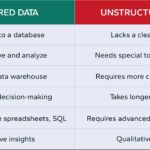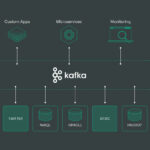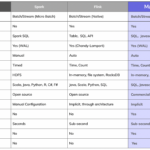In the realm of Big Data processing, optimizing data pipelines is crucial for ensuring efficiency, scalability, and faster processing speeds. A well-structured and optimized data pipeline can significantly enhance the performance of Big Data processing tasks, enabling organizations to harness the full potential of their data resources. By strategically designing and fine-tuning data pipelines, businesses can streamline data flow, minimize bottlenecks, and enhance overall data processing speed and reliability. In this article, we will explore key strategies and best practices for optimizing data pipelines to achieve faster Big Data processing outcomes.
Understanding Data Pipelines
A data pipeline refers to a series of data processing steps. It allows for the collection, transformation, and storage of data, enabling organizations to gain valuable insights. With the rise of big data, optimizing these pipelines is essential for achieving high performance and reliability. In this article, we will explore various methods and strategies for optimizing data pipelines to ensure faster big data processing.
1. Optimize Data Ingestion
The first step in creating an efficient data pipeline is to focus on data ingestion. This process involves gathering and importing data from various sources. Here are some best practices:
- Use Batch vs. Stream Processing: Decide whether to use batch processing, streaming, or a combination of both based on your business requirements. Batch processing is best suited for large volumes of data, while streaming works for real-time applications.
- Leverage Parallel Processing: Make use of parallel processing techniques to ingest multiple streams of data simultaneously. This approach minimizes bottlenecks and improves data throughput.
- Data Compression: Implement data compression methods to reduce the amount of data being transferred. This practice results in faster ingestion times and lower bandwidth usage.
2. Streamline Data Transformation
Once data is ingested, the next phase is data transformation. This is where raw data gets cleaned and organized. Optimize this step by:
- Utilizing ETL vs. ELT: Evaluate whether to use Extract, Transform, Load (ETL) or Extract, Load, Transform (ELT) depending on the volume of data and processing capabilities. ELT leverages the power of data lakes to perform transformations after loading the data.
- Automation: Automate repetitive transformation tasks using tools like Apache Nifi or Apache Airflow. Automation minimizes human error and speeds up the process.
- Optimize SQL Queries: If using SQL for transformations, ensure that your queries are optimized. Use indexing, join techniques, and sub-queries effectively to enhance performance.
3. Adoption of Distributed Systems
Speed and efficiency are greatly enhanced by incorporating distributed computing systems. These systems allow data processing to occur across multiple nodes. Consider:
- Utilizing frameworks like Apache Spark: Spark can process large data sets quickly due to its ability to operate in-memory, which eliminates the need for disk I/O.
- Leveraging Apache Hadoop: Hadoop is another distributed system that supports data storage and processing. It is particularly beneficial for handling massive datasets through its HDFS (Hadoop Distributed File System).
- Containerization: Using containerized environments (like Docker) ensures consistency and quick scaling of your data processing applications, allowing better resource utilization.
4. Improve Data Storage Efficiency
Efficient data storage contributes significantly to the performance of data pipelines. Consider the following strategies:
- Data Partitioning: Partition your data in a manner that reduces the I/O required for queries and processing. This can especially be helpful in systems like Hive or Amazon S3.
- Choose the Right Storage Format: Utilize columnar storage formats, such as Parquet or ORC, which are designed for big data processing. These formats improve read performance and reduce storage costs.
- Implement Data Retention Policies: Establish clear policies regarding how long to retain data. Deleting or archiving outdated information helps maintain a cleaner, faster pipeline.
5. Monitor and Optimize Performance
Continuous monitoring and optimization of data pipeline performance is vital for maintaining speed. Take the following measures:
- Use Monitoring Tools: Implement monitoring solutions like Apache Kafka Monitoring or Datadog to track performance metrics, identify bottlenecks, and fine-tune your pipeline.
- Conduct Regular Audits: Regular performance audits of your data pipeline help catch potential issues early, allowing for timely implementations of solutions.
- A/B Testing for Changes: When making significant changes to your data pipeline, employ A/B testing to ensure new implementations produce the desired effect before full-scale deployment.
6. Streamline Error Handling and Recovery
Errors are inevitable in data processing; hence, effective error handling is crucial for operational efficiency. Implement the following:
- Logging and Alerting: Maintain extensive logs for your data pipeline processes. Implement alert systems to notify relevant personnel of errors, ensuring a quick resolution.
- Graceful Recovery Mechanisms: Design your data pipelines to recover gracefully from failures, minimizing disruptions and ensuring data integrity.
- Retry Logic: Implement automatic retry logic for transient errors during processing to automatically handle temporary failures without manual intervention.
7. Train Your Team
Investing in the training and development of your team is often overlooked but is essential for effective data pipeline management:
- Workshops and Training Sessions: Regular training on the latest tools and best practices can significantly improve team performance when handling big data.
- Encourage Knowledge Sharing: Promote knowledge-sharing culture within teams to capitalize on experiences and solutions already discovered.
- Collaborative Tools: Utilize collaborative tools and platforms to allow team members to contribute to the optimization of data pipelines collectively.
8. Consider Cloud Solutions
Many organizations are migrating their data infrastructure to the cloud for improved scalability and performance. Consider the benefits of cloud solutions:
- Elasticity: Cloud services like AWS, Google Cloud, and Azure provide resource elasticity, enabling auto-scaling based on demand.
- Managed Services: Leverage managed services such as AWS Glue or Google Cloud Dataflow that abstract much of the complexity of data pipeline management.
- Cost Efficiency: Cloud solutions often provide lower upfront costs and allow for pay-as-you-go models, making them financially accessible for organizations of all sizes.
9. Leverage Machine Learning for Predictive Insights
Using machine learning algorithms within your data pipelines can lead to newer insights and automated processes:
- Predictive Analytics: Implement predictive analytics to foresee potential issues within data processing flows, allowing for proactive rather than reactive management.
- Anomaly Detection: Deploy machine learning models for anomaly detection to automatically identify and respond to unusual behavior in data processing.
- Model Optimization: Utilize machine learning techniques to continuously optimize various parameters of your data pipeline based on performance metrics over time.
Optimizing data pipelines is essential for achieving faster big data processing. By implementing efficient data storage, parallel processing, and data compression techniques, organizations can significantly improve the performance of their big data pipelines. Prioritizing scalability, fault tolerance, and data quality is key to ensuring successful data processing operations in the rapidly evolving landscape of big data analytics.














